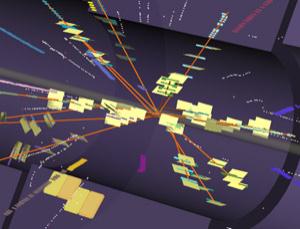|

by David Shiga
23 November 2009
from
NewScientist Website
The Large Hadron Collider bashed
protons together for the first time on Monday (23 November 2009),
inaugurating a new era in the quest to uncover nature's deepest
secrets.
Housed in a 27-kilometre circular underground tunnel near Geneva,
Switzerland, the LHC is the world's most powerful particle
accelerator, designed to collide protons together at unprecedented
energies.
It was on the verge of its first proton collisions in September 2008
when a faulty electrical connection triggered an explosion of helium
used to cool the machine.
This caused a 14-month delay while CERN
repaired the damage and installed safety features to prevent a
repeat of the accident.

The LHC's first
collisions occurred on 23 November in the ATLAS detector, as
reconstructed here
(Image: CERN)
But physicists started whipping protons around the machine again on
Friday.
Now, at long last,
CERN is heralding the first collisions inside the
machine. Two beams of protons traveling at nearly the speed of light
crashed together on Monday at 13:22 GMT inside the ATLAS detector,
one of the giant measuring devices the LHC will use to probe
shrapnel from the collisions, according to CERN's announcement.
Further collisions occurred inside the
LHC's CMS and LHCb detectors.
"This is great news, the start of a
fantastic era of physics – and hopefully discoveries – after 20
years' work by the international community to build a machine
and detectors of unprecedented complexity and performance," said
Fabiola Gianotti, a spokesperson for the ATLAS detector project.
The protons collided with 900 billion
electron volts of energy (900 GeV),
with 450 GeV supplied by each beam. The LHC is designed to allow
collisions at much higher energies – all the way up to 14,000 GeV
(14 TeV), or 7 TeV per beam.
World record
Before a brief shutdown of the LHC for Christmas, CERN hopes to
boost the energy to 1.2 TeV per beam – exceeding the world's current
top collision energies of 1 TeV per beam at the
Tevatron accelerator in Batavia,
Illinois.
In early 2010, physicists will attempt to ramp up the energy to 3.5
TeV per beam, collect data for a few months at that energy, then
push towards 5 TeV per beam in the second half of the year.
The LHC has the potential to make new discoveries even before it
ramps up to its highest energies, Gianotti said in a CERN
press conference on Monday.
"[At] an energy of 3.5 TeV per beam,
we do have a discovery potential which goes beyond the present
detectors, so we may discover something new already next year,"
she said.
Supersymmetric
dark matter
Dark matter particles predicted by
supersymmetry – a theory that proposes hidden connections between
matter particles and particles that transmit forces – might be an
early discovery of the LHC, depending on how much the particles
weigh, said CERN director-general Rolf Heuer.
"If nature has really realized dark
matter in the form of supersymmetric low-mass particles, then
this will be the first thing they can discover," he said.
If the supersymmetric particles
are heavier or do not exist, then the LHC's first discovery might be
a sighting of the
Higgs boson, which is thought to
endow other particles with mass and would complete the so-called
standard model of physics.
Physicists are already designing successors to the LHC that could
reach even higher energies, such as the Super Large Hadron
Collider.
|

